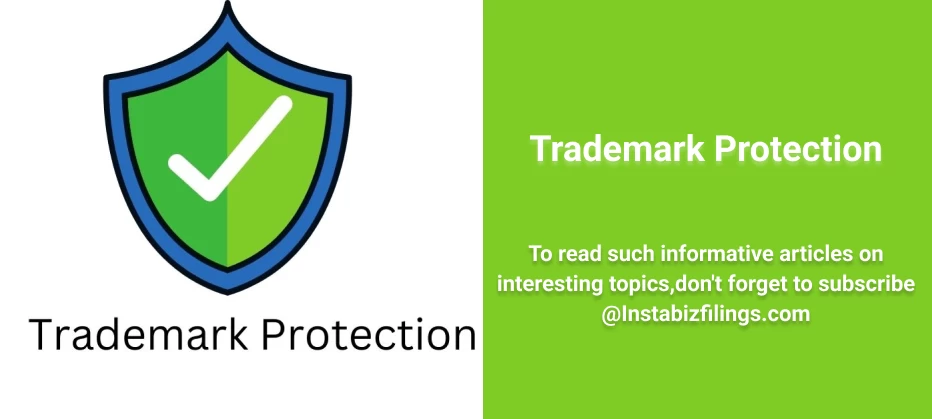
Trademark Protection
September 18, 2025 by Team Instabizfilings
Introduction to Trademark Protection
-
What is a Trademark? : A trademark is an identifying symbol, term, phrase, logo or design used to distinguish the products or services of one business from those of another business. It serves as a source identifier, and this has made the consumers recognize the brand or source of the commodity or the service.
-
Importance of Trademark Protection : The trademark protection is utilised in order to ensure that the businesses have established their intellectual property, secured the reputation of the brand and avoided confusion in the market. It also ensures that the firms are not exploited by others who can make use of their distinctive marks at the expense of their own brands.
Types of Trademarks
-
Word Marks: Trademarks consisting solely of words, letters, numbers, or combinations thereof.
-
Design Marks (Logos): Trademarks made up of logos, designs, or graphics.
-
Sound Marks: Unique sounds that represent a brand (e.g., Intel's “bong” sound).
-
Color Marks: Colors that are used in a distinctive way to identify a brand (e.g., the specific shade of Tiffany blue).
-
Shape Marks: The shape or packaging of a product that can be associated with a brand (e.g., Coca-Cola’s bottle shape).
-
Service Marks: Just like trademarks, but they are applied to identify services and not products.
How to Protect a Trademark
-
Registration Process:
- Trademark Search: Before applying for trademark protection, a comprehensive search should be conducted to ensure that the desired trademark is not already in use.
- Filing the Application: The trademark owner must apply with the relevant trademark office (e.g., the United States Patent and Trademark Office (USPTO) in the U.S., or the European Union Intellectual Property Office (EUIPO)).
- Examination and Approval: The application is scrutinised by a trademark examiner to determine whether it meets the trademark laws. In case of no problem, the trademark will be registered.
- Publication: Once approved, the trademark is published in an official gazette for a period during which third parties can object if they believe the trademark conflicts with their own rights.
- Issuance of Registration: If no objections are raised, the trademark is registered, and the owner is granted exclusive rights to the mark.
-
Unregistered Trademarks: A business can be registered or not and still enjoy trademark rights under the common law. Such rights emerge due to the real usage of the trademark in trade but such are narrower than in registered trademarks.
Duration of Trademark Protection
Trademark protection is generally granted for 10 years, after which it can be renewed indefinitely as long as the mark is still in use and the renewal fees are paid. The protection can be cancelled in case the trademark is not in use over a long period (in most jurisdictions 3 years).
Enforcing Trademark Rights
-
Infringement: Trademark infringement: infringement will arise when the third party uses a trademark, or a mark that is confusingly similar to a registered trademark thus resulting in the consumer being confused.
-
Legal Actions:
- Cease and Desist Letters: The first step in enforcing trademark rights is often sending a cease and desist letter to the infringer, demanding that they stop using the conflicting trademark.
- Litigation: If the infringer does not comply, trademark owners can file a lawsuit in the courts of the relevant jurisdiction or seek remedies through the trademark office.
- Alternative Dispute Resolution (ADR): Some jurisdictions offer alternative mechanisms like mediation or arbitration for resolving trademark disputes.
Trademark Dilution and Famous Marks
-
Dilution: Even if there is no direct competition between two marks, the use of a similar mark may dilute the distinctiveness or reputation of a famous trademark. Well-known marks (such as Coca-Cola, Apple or McDonalds) enjoy greater protection, even against dilution.
-
Types of Dilution:
- Blurring: In case a mark is diluted by unauthorised use.
- Tarnishment: The reputation of one mark is negatively affected by linking that mark to a bad or low-quality product or service.
International Trademark Protection
-
Trademarks are not usually secured outside of the jurisdiction where they are registered. International protection can however be realized by applying through:
- Madrid Protocol: An international treaty administered by the World Intellectual Property Organisation (WIPO) that allows for a single application to seek trademark protection in multiple countries.
- Community Trademarks (European Union): A single application to register a trademark across all EU member states.
- National Protection: Some countries require individual applications for trademark protection within their borders.
Common Mistakes to Avoid in Trademark Protection
-
Failing to Conduct a Trademark Search: It’s essential to check if your trademark is already in use before applying to avoid infringement.
-
Not Renewing the Trademark: Trademark registration should be renewed regularly. Failure to do this would result in the loss of trademark rights.
-
Inadequate Enforcement: Not actively monitoring and enforcing trademark rights can result in the loss of exclusivity.
Benefits of Trademark Protection
-
Exclusive Rights: Trademark registration grants exclusive rights to use the trademark, protecting against unauthorised use by others.
-
Market Identity and Brand Recognition: A Registered trademark has the potential to create a name and reputation of your brand in the market.
-
Legal Recourse: A registered trademark provides the legal means to prevent others from using similar marks and to take legal action against infringers.
-
Licensing and Franchising Opportunities: Trademarks can be licensed or franchised, allowing for revenue generation.
-
Asset Value: Trademarks can become valuable assets that add to a company’s overall worth.
Case Studies and Examples
-
Coca-Cola’s Trademark: Coca-Cola’s trademark includes a combination of its name and distinctive bottle shape. The company actively protects its trademark worldwide and has filed lawsuits to prevent infringement.
-
Apple Inc.: Apple’s iconic logo and the use of the word "Apple" are heavily protected under trademark law. The company has successfully fought cases related to trademark dilution and infringement.
-
McDonald’s Golden Arches: McDonald’s has extensive trademark protection for its "Golden Arches" logo, ensuring that no one can use a similar logo that could confuse consumers.
Recent Trends in Trademark Law
-
Nontraditional Trademarks: Unconventional trademarks like sound marks, color marks and motion marks are causing new complexities in trademark matters.
-
Online Trademark Enforcement: Due to the increased popularity of e-commerce, internet enforcement of marks has become more crucial, particularly in cases of fake products being distributed over sites such as Amazon and eBay.
Conclusion
Trademark protection is an essential part of any business's intellectual property strategy. It helps secure a brand’s identity, supports marketing efforts, and provides legal recourse if others infringe on the trademark. Businesses should ensure they properly register, monitor, and enforce their trademark rights to protect their brand in the long run.
Let me know if you’d like to expand on any specific section or if you need examples, case studies, or further details!
Disclaimer
The information provided in this blog is purely for general informational purposes only. While every effort has been made to ensure the accuracy, reliability and completeness of the content presented, we make no representations or warranties of any kind, express or implied, for the same.
We expressly disclaim any and all liability for any loss, damage or injury arising from or in connection with the use of or reliance on this information. This includes, but is not limited to, any direct, indirect, incidental, consequential or punitive damage.
Further, we reserve the right to make changes to the content at any time without prior notice. For specific advice tailored to your situation, we request you to get in touch with us.


